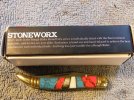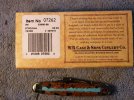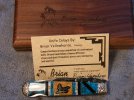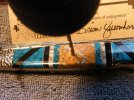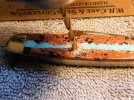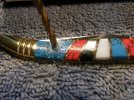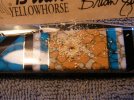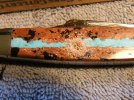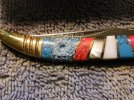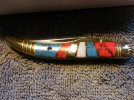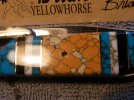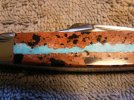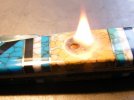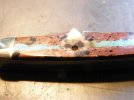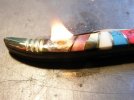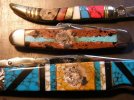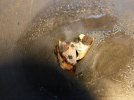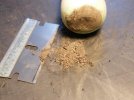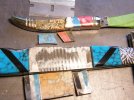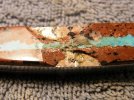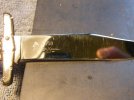- Joined
- May 21, 2007
- Messages
- 1,432
Most "stone" used by other makers on knives is not really even stone but rather rock dust reconstituted with plastics and dyed to look like stone such as Turquoise. Fake stone is being used by, Case, Frost, Schrade and Rough Riders and even the Yellowhorse brothers.
If you have any question about a seller or a specific knife this is the thread to ask about my opinion of the material being used.
I only use real stone and the only thing I will do is improve the polish some stone pieces will take by filling in natural occurring structures such as pits, druzy, and lines with a UV stable polymer (usually museum grade Hxtal). Turquoise I use is the only fully treated stone which is called stabilized Turquoise. Stabilized Turquoise is naturally occurring Turquoise that is too soft (chalky) to use without addition of probably about 15% by weight of a UV stable polymer under high pressure. This is done by just a couple of commercial companies and the basic structure of the stabilized turquoise is not changed in the process. It is simply impossible to buy untreated SOLID Turquoise in pieces large enough to use as knife scales.
This Lapidary linked site has hundreds of postings I have made and tutorials I have written to help others attain the best possible polish on their stone, adhesion of stone to metal, and even on how to do custom knife scales.
Lapidary / Gemstone Community Forum
http://gemstone.smfforfree4.com/
If you have any question about a seller or a specific knife this is the thread to ask about my opinion of the material being used.
I only use real stone and the only thing I will do is improve the polish some stone pieces will take by filling in natural occurring structures such as pits, druzy, and lines with a UV stable polymer (usually museum grade Hxtal). Turquoise I use is the only fully treated stone which is called stabilized Turquoise. Stabilized Turquoise is naturally occurring Turquoise that is too soft (chalky) to use without addition of probably about 15% by weight of a UV stable polymer under high pressure. This is done by just a couple of commercial companies and the basic structure of the stabilized turquoise is not changed in the process. It is simply impossible to buy untreated SOLID Turquoise in pieces large enough to use as knife scales.
This Lapidary linked site has hundreds of postings I have made and tutorials I have written to help others attain the best possible polish on their stone, adhesion of stone to metal, and even on how to do custom knife scales.
Lapidary / Gemstone Community Forum
http://gemstone.smfforfree4.com/
Last edited:

